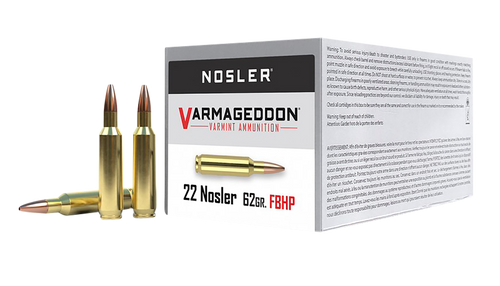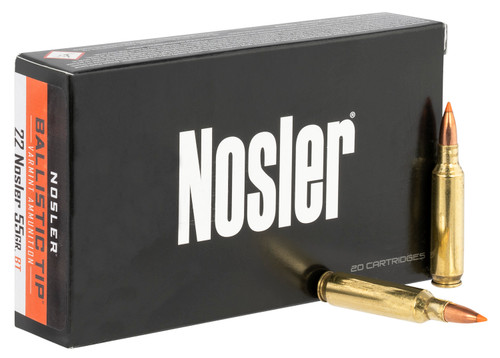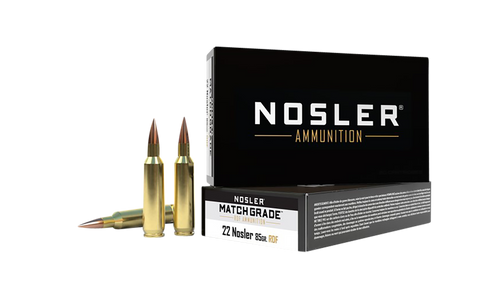.22 Nosler Ammo
Professionally Reviewed by:
Nathaniel Boos

Nathaniel Boos is a lifelong firearms enthusiast and shooter, renowned for his experience as a long-range shooter, ammunition importer/exporter, and firearms manufacturer. With years of hands-on experience, he is a trusted authority in the ammunition and firearms industry.
Credentials:
- • 2x Team Safari Competitor
- • KRG Training Level 1, 2, and Force on Force CQB certified
- • Licensed Texas Conceal Carry Holder
- • Kranz Firearms Training Group Advanced Carbine Certified
.22 Nosler: At a Glance
| Key Characteristics | |
|---|---|
| Firearm Type | Rifle |
| Primer Type | Small Rifle |
| Used For | Varmint Hunting, Target Shooting, Competition |
| Case Design | Rimless, Bottleneck |
| Year Introduced | 2017 |
.22 Nosler: At a Glance: Pros and Cons
Pros
- ✔ Higher velocity than .223 Remington
- ✔ Excellent accuracy potential
- ✔ Flat trajectory for long-range shooting
- ✔ Good performance for varmint hunting
- ✔ Compatible with AR-15 platform with minimal modifications
Cons
- ✘ Less widely available than more common calibers
- ✘ More expensive than .223 Remington
- ✘ Shorter barrel life due to higher pressures
- ✘ Limited factory ammunition options
- ✘ Not as versatile for larger game hunting
.22 Nosler Ammo: In Depth
The .22 Nosler is a high-performance rifle cartridge designed to maximize the potential of the AR-15 platform. Introduced by Nosler in 2017, this cartridge offers superior ballistics compared to the .223 Remington and .224 Valkyrie, delivering higher velocities and greater energy while maintaining compatibility with standard AR-15 bolt faces and magazines. The .22 Nosler has quickly gained popularity among hunters, competitive shooters, and firearms enthusiasts for its impressive performance and versatility.
Development and Features
The .22 Nosler was developed by Nosler, Inc. to bridge the performance gap between the .223 Remington and larger cartridges like the .22-250 Remington. It features a rebated rim design that allows it to function in AR-15 rifles with minimal modifications. The case capacity of the .22 Nosler is approximately 10% greater than that of the .223 Remington, enabling higher velocities and increased downrange energy.
One of the key advantages of the .22 Nosler is its ability to push heavier bullets at higher velocities compared to the .223 Remington. This results in improved long-range performance and enhanced terminal ballistics, making it an excellent choice for both target shooting and hunting applications. The cartridge is capable of propelling a 55-grain bullet at velocities exceeding 3,350 fps from a 24-inch barrel, surpassing the .223 Remington by about 300 fps.
The .22 Nosler's design allows for easy conversion of existing AR-15 rifles. By simply changing the upper receiver and using appropriate magazines, shooters can upgrade their rifles to this high-performance cartridge without the need for extensive modifications or a new firearm purchase. T
Applications and Performance
The .22 Nosler excels in a variety of shooting disciplines. For hunters, it offers improved performance on varmints and predators at extended ranges, with the ability to effectively take medium-sized game when using appropriate bullets. The cartridge's flat trajectory and high velocity make it particularly well-suited for long-range target shooting and competitions.
The .22 Nosler has also found favor among reloaders due to its efficiency and versatility. The cartridge responds well to a wide range of powders and bullet weights, allowing handloaders to develop custom loads tailored to their specific needs and preferences.
Timeline of .22 Nosler Development:
.22 Nosler Performance
The .22 Nosler offers superior ballistic performance compared to similar cartridges in its class. Here's a breakdown of its key performance characteristics:
| Characteristic | Performance |
|---|---|
| Velocity | 3,350 fps (55-grain bullets)\n3,000 fps (77-grain bullets) From a 24-inch barrel |
| Energy | 1,370 ft-lbs at the muzzle (55-grain bullets) Provides excellent performance for varmints and medium-sized game |
| Trajectory | Flatter trajectory than .223 Remington Effective for long-range shooting beyond 600 yards |
| Recoil | Slightly higher than .223 Remington Remains manageable in AR-15 platform rifles |
| Accuracy | Sub-MOA accuracy potential Excellent for precision shooting and competitions |
Bullet Weight vs. Muzzle Velocity
This chart shows how bullet weight affects muzzle velocity for common .22 Nosler loads.
.22 Nosler: Effective Range for Different Applications
This table provides estimated effective ranges for .22 Nosler ammunition in various applications. Ranges are based on typical bullet weights and velocities.
| Application | Effective Range (yards) | Notes |
|---|---|---|
| Varmint Hunting | 0-400 | Excellent for small to medium-sized varmints |
| Target Shooting | 0-600 | Capable of long-range accuracy with proper loads |
| Medium Game Hunting | 0-300 | Suitable for deer-sized game with proper bullet selection |
| Competitive Shooting | 0-800 | Used in long-range competitions due to its flat trajectory |
Note: Effective ranges can vary based on factors such as bullet selection, shooter skill, wind conditions, and specific firearm characteristics. The .22 Nosler is known for its high velocity and flat trajectory, offering excellent performance at longer ranges. Always prioritize safety and adhere to local laws and regulations.
Applications for .22 Nosler
The .22 Nosler's high velocity and flat trajectory make it suitable for a range of applications:
Caliber Comparisons
To understand the .22 Nosler's place in the rifle world, it's helpful to compare it to similar cartridges. Click on each comparison to see more details:
Recoil Energy Comparison
Compare the estimated recoil energy of .22 Nosler with other popular rifle cartridges. (Based on a 7.5 lb rifle)
Ballistic Trajectory Comparison
This chart compares the ballistic trajectory (bullet drop) of .22 Nosler with other popular rifle cartridges over distance.
Wind Drift Comparison
This chart compares the wind drift of .22 Nosler with other popular rifle cartridges in a 10 mph crosswind.
Energy Retention Comparison
This chart compares the energy retention of .22 Nosler with other popular rifle cartridges over distance.
Sectional Density Comparison for .22 Nosler Ammo
Sectional density is a measure of a bullet's mass relative to its diameter. The .22 Nosler, introduced in 2017, offers improved ballistics over the .223 Remington while maintaining compatibility with AR-15 platforms.
| Cartridge | Bullet Weight (gr) | Sectional Density |
|---|---|---|
| .22 Nosler | 55 | 0.157 |
| .22 Nosler | 70 | 0.199 |
| .22 Nosler | 77 | 0.219 |
| .22 Nosler | 85 | 0.242 |
| .223 Remington | 55 | 0.157 |
Note: The .22 Nosler offers higher velocities and improved ballistics compared to the .223 Remington, while maintaining the same bullet diameter. This results in identical sectional densities for the same bullet weights, but the .22 Nosler's higher velocity contributes to improved downrange performance.







